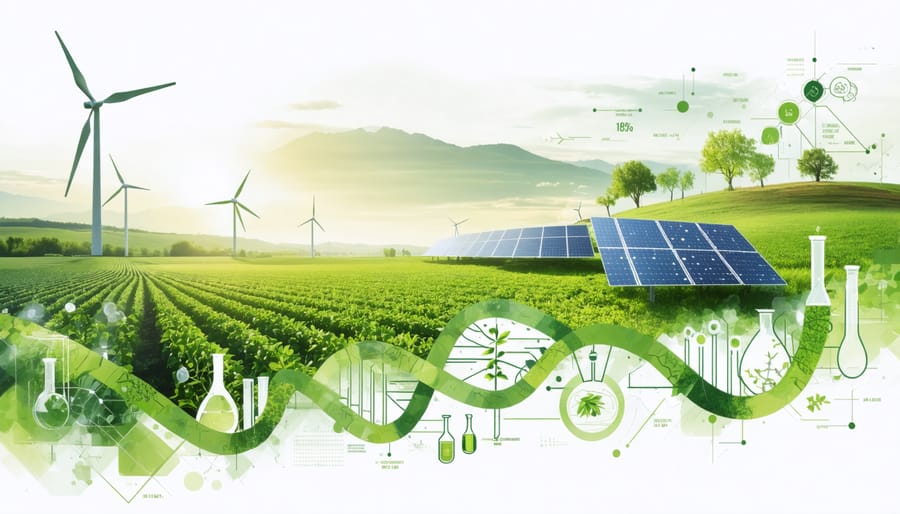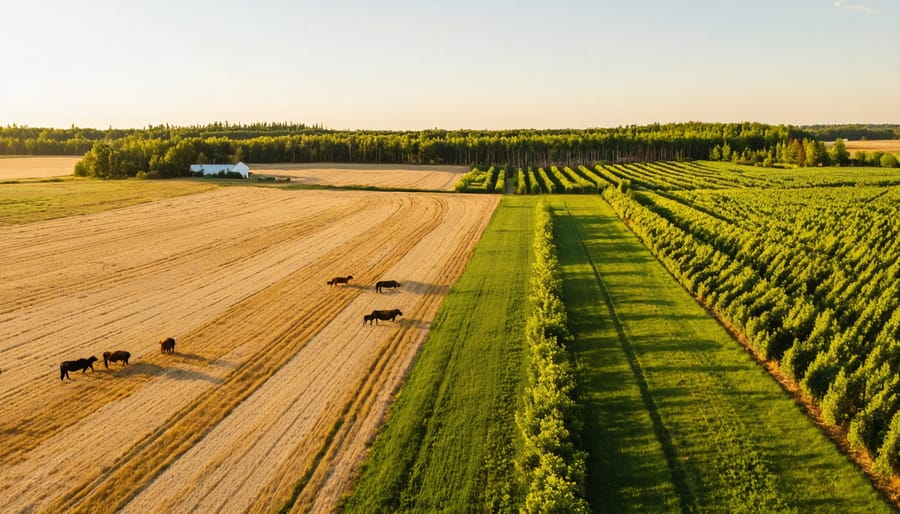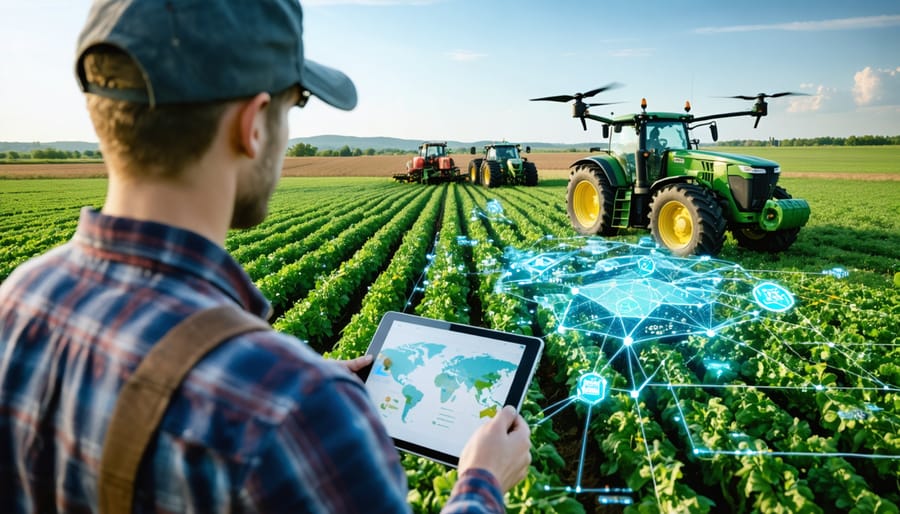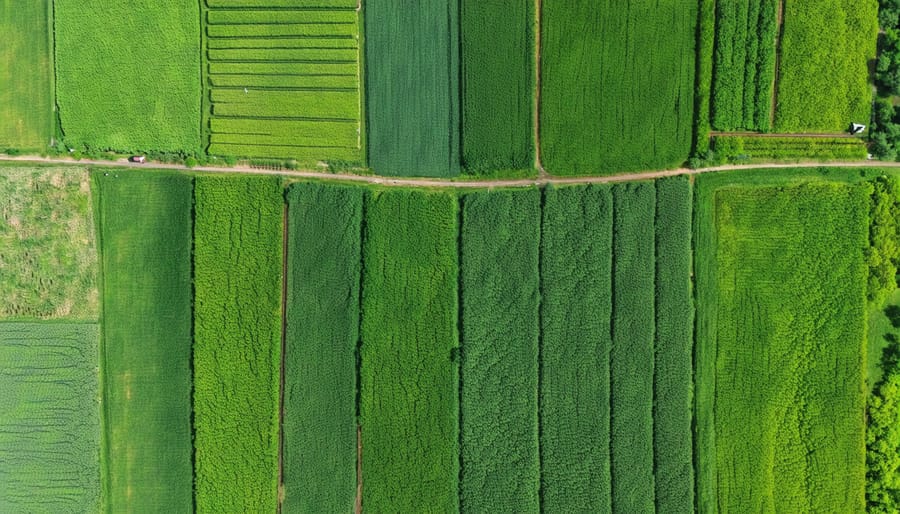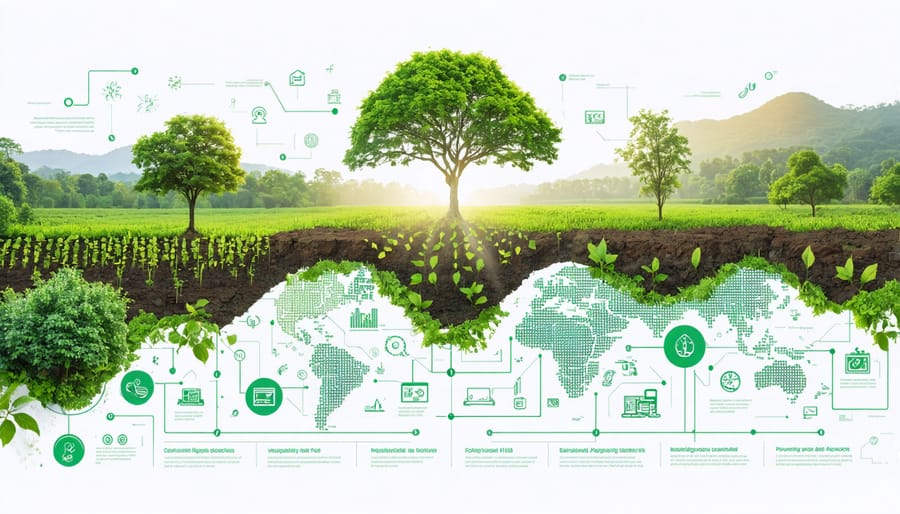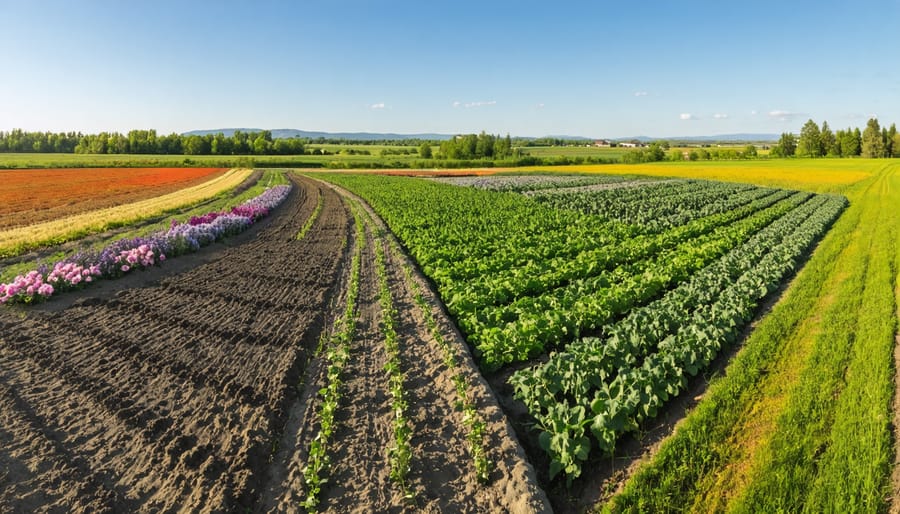The bioeconomy represents a transformative shift in how we harness biological resources to create sustainable economic value. From Alberta’s vast agricultural lands to cutting-edge biotechnology labs, this emerging economic model leverages renewable biological materials to produce food, energy, and high-value products while reducing our dependence on fossil fuels. For Canadian farmers, the bioeconomy opens new revenue streams through innovative crop utilization, waste-to-resource conversion, and participation in sustainable supply chains. This economic framework isn’t just about replacing traditional products with bio-based alternatives—it’s about reimagining our entire production system to create a more resilient, circular economy that benefits both rural communities and the environment. As global markets increasingly demand sustainable solutions, understanding and engaging with the bioeconomy has become essential for agricultural producers looking to stay competitive while contributing to Canada’s climate goals. The concept encompasses everything from traditional farming practices to advanced biomanufacturing, creating a bridge between our agricultural heritage and a technology-driven future.
What Makes Up Canada’s Agricultural Bioeconomy
Core Elements of Agricultural Bioeconomy
The agricultural bioeconomy rests on three fundamental pillars that work together to create a sustainable and profitable system. At its foundation is biomass production – the cultivation of crops, livestock, and other biological resources that serve as raw materials. Here in Alberta, this includes everything from our traditional wheat and canola crops to newer opportunities like hemp and specialized grains.
The second pillar involves processing these raw materials into valuable products. Local processing facilities transform agricultural outputs into food products, biofuels, biochemicals, and other high-value items. For instance, several Alberta-based facilities now convert canola into both food products and renewable diesel fuel, maximizing the value of each harvest.
The third pillar focuses on developing and maintaining efficient value chains. This encompasses the entire journey from farm to final product, including transportation, storage, marketing, and distribution networks. Strong value chains ensure that farmers receive fair compensation while delivering quality products to consumers.
These elements are interconnected through innovation and technology. Many Canadian farmers are already implementing smart farming techniques and precision agriculture to optimize biomass production. Meanwhile, processing facilities are adopting new technologies to reduce waste and increase efficiency. By understanding and strengthening these core elements, farmers can better position themselves within the bioeconomy, creating new revenue streams while contributing to environmental sustainability.
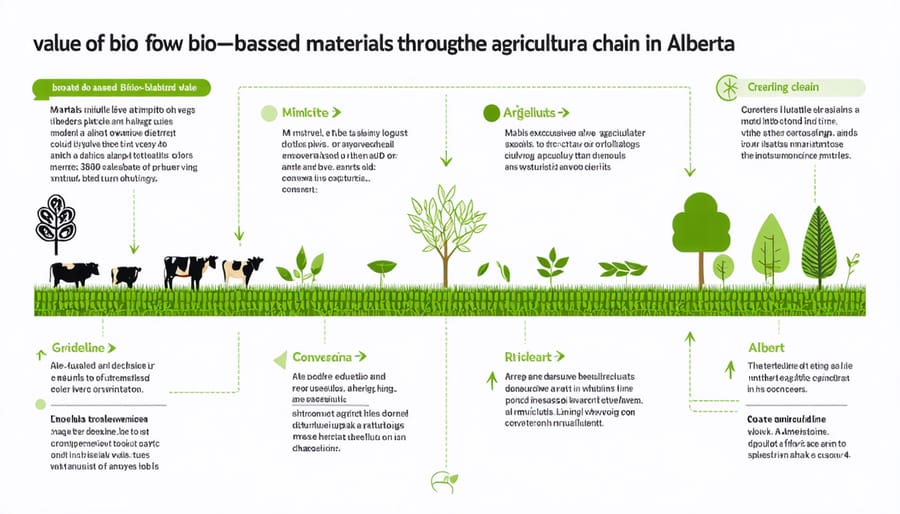
Regional Impact in Alberta
Alberta’s agricultural sector stands at the forefront of Canada’s bioeconomy transformation, with over 50 million acres of agricultural land providing abundant biomass resources. Local farmers are increasingly adopting bio-based practices, from converting crop residues into biofuels to developing value-added products from traditional crops.
The province’s canola industry exemplifies this shift, with farmers not only producing food oils but also contributing to the biofuel sector, which produced over 400 million litres of renewable diesel in 2022. Wheat straw, traditionally considered a waste product, is now being transformed into biodegradable packaging materials by innovative Alberta-based companies.
Local success stories include the Lethbridge Biogas facility, which converts agricultural waste into renewable natural gas, providing enough energy to power 2,800 homes annually. In the Peace River region, farmers are participating in carbon offset programs by implementing regenerative agriculture practices, creating additional revenue streams while contributing to environmental sustainability.
The provincial government’s Bioeconomy Action Plan supports these initiatives through grants and research funding, helping farmers transition to bio-based production methods. Educational programs at Olds College and the University of Alberta are training the next generation of agricultural professionals in bioeconomy practices, ensuring long-term industry growth.
This regional approach to bioeconomy has created over 1,500 new jobs in rural communities while reducing agricultural greenhouse gas emissions by an estimated 12% since 2015.
Sustainable Practices in Bioeconomy

Circular Agriculture Systems
In modern farming, circular agriculture systems are transforming how we think about waste and resource management. Here in Alberta, farmers are leading the way by implementing innovative approaches that turn traditional waste streams into valuable resources.
Consider how the Lethbridge region’s cattle operations are partnering with local crop farmers to create closed-loop systems. Manure from feedlots becomes organic fertilizer for crops, while crop residues return to feed livestock. This practical approach not only reduces waste but also cuts down on input costs.
Take the case of Sarah Thompson, a third-generation farmer near Red Deer, who transformed her operation by implementing a comprehensive composting system. By processing organic waste from her livestock and crop operations, she’s reduced her fertilizer costs by 40% while improving soil health.
The key to successful circular systems lies in viewing every output as a potential input. Crop residues can become livestock bedding, then compost, and finally return to the soil as nutrients. Even processing by-products find new life – damaged grain becomes livestock feed, while straw gets transformed into biogas or biodegradable packaging materials.
These systems not only benefit individual farms but strengthen our entire agricultural community by creating new revenue streams and reducing dependency on external inputs. By working together, we’re building a more resilient and sustainable agricultural future for Alberta.
Bio-based Solutions
Bio-based solutions are revolutionizing Canadian agriculture by offering natural alternatives to traditional chemical inputs. These solutions harness the power of biological processes and organisms to enhance crop production while reducing environmental impact.
Here in Alberta, farmers are increasingly adopting bio-fertilizers, which use beneficial microorganisms to improve soil fertility and plant nutrient uptake. These include rhizobacteria that fix nitrogen from the air and mycorrhizal fungi that help plants access phosphorus more efficiently. Local success stories, like the Morrison family farm near Red Deer, show how switching to bio-fertilizers has improved soil health while maintaining crop yields.
Biological pest control is another growing area, with farmers using predatory insects and beneficial nematodes to manage crop pests naturally. These solutions are particularly effective in greenhouse operations and specialty crop production. Biopesticides, derived from natural materials like plants and bacteria, offer targeted pest control without the residual effects of synthetic chemicals.
Bio-stimulants, including seaweed extracts and humic substances, are helping farmers enhance crop resilience to stress conditions, which is particularly valuable given our variable prairie climate. These products work with the plant’s natural processes to improve nutrient efficiency and stress tolerance.
These biological alternatives not only support sustainable farming practices but also align with consumer demand for environmentally responsible food production, opening new market opportunities for Canadian farmers.
Carbon Management
Effective carbon management is a crucial component of modern bioeconomy practices, particularly for Canadian farmers looking to reduce their environmental impact while maintaining profitable operations. By implementing smart carbon management strategies, Alberta farmers can significantly decrease their carbon footprint while potentially accessing carbon credit markets.
Key approaches include implementing no-till farming practices, which help retain soil carbon and reduce fuel consumption from machinery. Cover cropping between main growing seasons protects soil health while sequestering additional carbon. Many Alberta farmers have found success with rotational grazing systems, which optimize grass growth and enhance soil carbon storage.
Precision agriculture technology plays a vital role in carbon management. GPS-guided equipment and variable-rate applications help reduce fuel usage and optimize fertilizer application, cutting both costs and emissions. Installing renewable energy systems, such as solar panels for irrigation systems or barn operations, further reduces farm carbon footprints.
Local success stories show these strategies in action. The Thompson family farm near Red Deer reduced their carbon emissions by 30% over five years through a combination of these practices, while improving soil health and crop yields. They’re now participating in Alberta’s carbon offset program, creating an additional revenue stream while contributing to climate solutions.
Remember, small changes add up – even starting with one or two practices can make a meaningful difference in your farm’s carbon profile and bottom line.
Economic Benefits for Alberta Farmers

Value-Added Products
Value-added products represent an exciting frontier in Alberta’s bioeconomy, offering farmers new opportunities to diversify their income streams and contribute to sustainable agriculture. By processing raw agricultural materials into higher-value products, farmers can capture more value from their existing operations while meeting growing consumer demand for eco-friendly alternatives.
Consider how canola, one of Alberta’s primary crops, can be transformed beyond traditional oil production. Innovative farmers are now exploring opportunities in bio-based plastics, environmentally friendly lubricants, and specialized protein products. Hemp farmers are finding success in everything from building materials to health foods, while grain producers are partnering with local craft breweries and distilleries to create premium beverages.
“The key is identifying market gaps and consumer needs,” says Sarah Thompson, an agricultural economist at the University of Alberta. “We’re seeing tremendous success with farmers who develop specialty food products, natural health supplements, and bio-based construction materials.”
Local success stories include the Mackenzie family farm, which transformed their traditional grain operation into a profitable enterprise producing gluten-free flour alternatives, and the Prairie Biologicals Cooperative, where farmers collectively produce natural pest control solutions from plant extracts.
These value-added initiatives not only increase farm revenue but also create jobs in rural communities and support regional economic development. Programs through Alberta Agriculture and Forestry provide support for farmers interested in exploring value-added opportunities, including market research assistance and processing facility grants.
Government Support and Incentives
Canadian farmers looking to transition into bioeconomy practices have access to several government support programs and financial incentives. At the federal level, Agriculture and Agri-Food Canada offers the Agricultural Clean Technology Program, which provides funding for innovative bio-based projects and sustainable farming initiatives. This program can cover up to 50% of eligible project costs for individual farmers and up to 75% for Indigenous applicants.
In Alberta, the Biological Carbon Canada Initiative supports farmers implementing bio-based solutions, offering grants ranging from $10,000 to $500,000. The province’s Results Driven Agriculture Research (RDAR) program specifically funds research and development in bio-based agricultural practices, with funding cycles throughout the year.
The Scientific Research and Experimental Development (SR&ED) tax incentive program offers tax credits for farmers implementing innovative biological processes in their operations. Additionally, the Canadian Agricultural Partnership (CAP) provides cost-sharing opportunities for environmental stewardship projects, including those related to bioeconomy initiatives.
Local agricultural service boards across Alberta offer smaller-scale grants and technical support for farmers transitioning to bio-based practices. Many of these programs include mentorship opportunities, connecting experienced bio-economy practitioners with those just starting their journey.
To access these supports, farmers can connect with their local agricultural fieldman or visit their nearest Agriculture and Agri-Food Canada office. Regular workshops and information sessions are held throughout the province to help farmers navigate available funding options.
Getting Started with Bioeconomy Practices
Implementing bioeconomy practices on your farm doesn’t have to be overwhelming. Start by conducting a resource assessment to identify potential bio-based opportunities unique to your operation. Many Alberta farmers begin with crop residue management, converting agricultural waste into valuable products like biochar or renewable energy feedstock.
Consider starting small with these practical steps:
1. Map your biomass resources: Document available crop residues, animal byproducts, and organic waste streams on your property.
2. Connect with local networks: Join regional farmer cooperatives and bioeconomy initiatives. The Alberta Biomaterials Development Centre offers valuable resources and networking opportunities.
3. Explore value-added opportunities: Look into processing agricultural residues into higher-value products, such as using straw for bio-based packaging or converting manure into biogas.
4. Implement circular practices: Start composting, rotate crops effectively, and establish closed-loop systems that minimize waste while maximizing resource efficiency.
Remember that achieving a sustainable farm transformation takes time. Many successful Canadian farmers recommend starting with one project and gradually expanding as you gain experience and confidence.
Key resources to help you begin:
– Local agricultural extension offices
– Provincial biomass inventory maps
– Renewable energy incentive programs
– Sustainability certification guidelines
Start by setting achievable goals and measuring progress. Track improvements in soil health, waste reduction, and energy efficiency. Consider partnering with neighboring farms to share resources and knowledge, creating stronger local bioeconomy networks.
Remember to document your journey – successful bioeconomy initiatives often inspire others in the farming community. Many Alberta farmers report that their initial steps toward bio-based practices led to unexpected benefits, including reduced operating costs and new revenue streams.
The transition to a bioeconomy represents a crucial step forward for Canadian agriculture, offering both environmental benefits and economic opportunities. By embracing bio-based practices, we can strengthen our farming communities while contributing to a more sustainable future. Alberta’s agricultural sector is uniquely positioned to lead this transformation, with our rich natural resources and innovative farming community. Remember that every step toward bioeconomy adoption, whether large or small, makes a difference. From implementing crop rotation systems to exploring value-added bio-products, each action builds momentum toward a more sustainable agricultural future. Let’s work together to create a thriving bioeconomy that benefits our farms, our communities, and our environment. The path forward may have its challenges, but the potential rewards – both economic and environmental – make it a journey worth taking.

